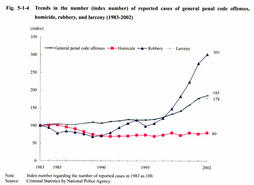| Previous Next Index Image Index Year Selection | |
|
|
With the aim of revealing the reality of the deteriorating circumstances of crimes in recent years, the 2001 White Paper attempted analysis focusing on larceny, the number of reported cases of which was particularly large among general penal code offenses, and the 2002 White Paper attempted analysis focusing on the 9 types of offenses of a violent nature (robbery, rape, indecent assault, extortion, intimidation, bodily injury, assault, destruction of objects, and breaking and entering), the number of reported cases for those other than larceny of which has been increasing significantly, for the purpose of seeking the causes of the deterioration in circumstances of crimes from a quantitative perspective. Since some of these 9 types of offenses of a violent nature include a considerable number of cases that are not reported, it would be possible to reveal the closer realities of the deteriorating circumstances of crimes by attempting detailed analysis focusing on specific types of offense for which the number of non-reported cases is smaller.
Among general penal code offenses, homicide and robbery (including homicide on the occasion of robbery, robbery resulting in death or bodily injury, and rape on the occasion of robbery) are considered to have the smallest number of non-reported cases. Particularly, the number of reported cases of robbery has been increasing rapidly in recent years and qualitative changes have been seen in terms of modes of committing the offense and the attribution of offenders. As for homicide, the number of reported cases has been leveling off or increasing slightly over the last 10 years after showing a downward trend, and when examining the trend closely, qualitative changes have also been seen in terms of modes of committing the offense and the attribution of offenders. Fig. 5-1-4 shows the fluctuations (in the index number regarding the figure for 1983 as 100) over the last 20 years in the numbers of reported cases of general penal code offenses, homicide, and robbery, as well as the number of reported cases of larceny, which accounts for more than 80% of all cases of general penal code offenses and has an influence on the overall trend. The numbers for general penal code offenses and larceny started to show an intensified upward trend in 1996 after continuing to rise gradually, and increased 1.5 to 1.6-fold over the period from 1996 to 2002. On the other hand, the number for homicide started to increase slightly in 1997 after showing a downward or flat trend whereas the number for robbery took an upward turn in 1990 after showing a gradual decline, and started to increase rapidly in 1996 beyond the upward trend seen in the numbers of general penal code offenses and larceny. The number of reported cases of robbery increased about 3-fold from 1995 to 2002. Fig. 5-1-4 Trends in the number (index number) of reported cases of general penal code offenses, homicide, robbery, and larceny (1983-2002) In 2002, robbery and homicide only accounted for small shares, 0.24% and 0.049%, of the total number of reported cases of general penal code offenses respectively. However, homicide and robbery are offenses that endanger or are very likely to endanger human life directly, and most serious cases of dangerous and malicious crimes that have actually occurred are these two types of offenses. Furthermore, considering that these serious offenses may naturally be brought about in the course of people's life in the society and therefore the trends of these offenses cannot be irrelevant to the trends of general penal code offenses and they have an immense influence on people's sense of insecurity, these heinous offenses are indisputably important in the analysis of crime situations. For this reason, analyzing the trends of these heinous offenses from various perspectives and identifying the actual conditions and background factors thereof will contribute to taking effective measures to prevent crimes and treat offenders appropriately.As for the trends in the number of persons cleared, the share of juveniles in the number of persons cleared for robbery has been increasing significantly in recent years, and in particular, a drastic increase has been seen in the number of cases in which juveniles have committed robbery on the street in a group. Furthermore, juveniles have been committing a succession of homicide offenses and attracting public attention. The increase in the number of these heinous offenses committed by juveniles may be one of the factors causing increasing insecurity about public peace among the people. We need to identify the characteristics of juveniles who have committed heinous offenses and analyze problems behind such offenses, thereby providing useful references for preventing delinquency and encouraging rehabilitation of juveniles. The 2003 White Paper focuses, among general penal code offenses, on heinous offenses, i.e. homicide and robbery, in which the public have the keenest interest and which seriously harm people's lives, bodies, and property, as indicators to clarify the reality of the deteriorating circumstances of crimes, and under the title "Changing Nature of Heinous Offenses and Countermeasures against Them," examines the trends of these heinous offenses from various perspectives. To this end, this White Paper first identifies the overall trends of heinous offenses based on statistical data, and then examines and analyzes the actual conditions and background factors of heinous offenses, according to the results of special surveys regarding serious and malicious offenses that the majority of people are concerned about, or "cases of heinous offenses for which the death penalty or life imprisonment was demanded by prosecutors (homicide and robbery)" as well as robbery cases committed by juveniles, which have been increasing significantly in recent years. |
